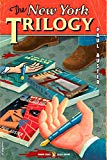
Ostensibly presented as detective fiction, the stories of The New York Trilogy have been described as "meta-detective-fiction", "anti-detective fiction", "mysteries about mysteries", a "strangely humorous working of the detective novel", "very soft-boiled", a "metamystery" and a "mixture between the detective story and the nouveau roman". This may classify Auster as a postmodern writer whose works are influenced by the "classical literary movement" of American postmodernism through the 1960s and 70s. There is, however, "a certain coherence in the narrative discourse, a neo-realistic approach and a show of responsibility for social and moral aspects going beyond mere metafictional and subversive elements", which distinguish him from a "traditional" postmodern writer.
The New York Trilogy is a particular form of postmodern detective fiction which still uses well-known elements of the detective novel (the classical and hardboiled varieties, for example) but also creates a new form that links "the traditional features of the genre with the experimental, metafictional and ironic features of postmodernism."
A 2006 reissue by Penguin Books is fronted by new pulp magazine-style covers by comic book illustrator Art Spiegelman.
The first story, City of Glass , features a detective-fiction writer become private investigator who descends into madness as he becomes embroiled in a case. It explores layers of identity and reality, from Paul Auster the writer of the novel to the unnamed "author" who reports the events as reality to "Paul Auster the writer", a character in the story, to "Paul Auster the detective", who may or may not exist in the novel, to Peter Stillman the younger, to Peter Stillman the elder and, finally, to Daniel Quinn, protagonist.
"City of Glass" has an intertextual relationship with Cervantes' Don Quixote. Not only does the protagonist Daniel Quinn share his initials with the knight, but when Quinn finds "Paul Auster the writer," Auster is in the midst of writing an article about the authorship of Don Quixote. Auster calls his article an "imaginative reading," and in it he examines possible identities of Cide Hamete Benengeli, the narrator of the Quixote.
The second story, Ghosts , is about a private eye called Blue, trained by Brown, who is investigating a man named Black on Orange Street for a client named White. Blue writes written reports to White who in turn pays him for his work. Blue becomes frustrated and loses himself as he becomes immersed in the life of Black.
The Locked Room is the story of a writer who lacks the creativity to produce fiction. Fanshawe, his childhood friend, has produced creative work, and when he disappears the writer publishes his work and replaces him in his family. The title is a reference to a "locked room mystery", a popular form of early detective fiction.
Already have an account? Log In Now